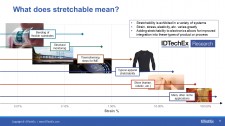Stretching Electronics: The Form Factor Innovation Driving New Market Opportunities

BOSTON, June 26, 2019 (Newswire.com) - IDTechEx focuses on many different emerging technologies, many of which are related to the development of new form factors in electronics. Whilst many people are familiar with flexible electronics, whether it be in a folding smartphone, RFID tag or glucose test strip, the area of stretchable electronics has seen waves of innovation and commercial development, particularly over the last five years. The IDTechEx report “Stretchable and Conformal Electronics 2019-2029” provides all of the information that is required in order to understand this emerging trend and its commercial connotations.
"Stretchable" means different things to different people. The report explores the meaning of the term, looking at absolute measurements such as strain tolerance, number of cycles, and so on, but also considering wider connotations around the term. For example, the rise in interest and discussion of stretchable electronics has been closely linked to a parallel rise in interest around "wearables" or "wearable electronics". A prominent narrative within that sector states that the majority of devices that are "components-in-a-box" designs, often using like-for-like components with smartphones, strapped to the body, but that what the industry needs is to move to new form factors to recognise the need for comfortable, conformal devices to wear on the body. This links into certain product types, including Electronic Skin Patches, and E-textiles, but also links closely to the idea of stretchable electronics. In fact, linguistic features often mean that "stretchable" and "wearable" can even be used fairly interchangeably, particularly in Asian languages, further reinforcing the link between the two topics.
The result has been waves of new R&D investment around stretchable electronics, including the integration of electronics into clothing via conductive inks, exploration of new substrate options and materials to enable improved strain tolerance, and reviews of design approaches to enable stretchable electronics to be more easily integrated in a reliable and reproducible way. We have seen many players develop new material options, particularly around conductive inks and substrates, in order to address these needs. This also links onto many different component types that can be developed from these core materials, all enabling a full toolkit of stretchable electronic parts which designers can begin to integrate into products. The report explores both commercial options, as well as the leading edge of academic developments, particularly in more complicated component types such as ICs, batteries, energy harvesters, and more.
At the most fundamental level, development of stretchable electronic materials typically involves the development of conductive elements which can be printed onto different substrates. Where "stretchability" may be the original objective, optimization of the materials for the new substrate options offers potentially unforeseen advantages. These new substrate options may come with other advantageous properties which can give them an edge over competition in a variety of applications. For example, a new material such as silicone could have improved tactile qualities, enabling integration onto a surface used as a user interface. The new material could have improved compatibility with different surface treatment options or other steps within a manufacturing process. Finally, there have also been advantages where even something like the acoustic properties of a material are superior to that of the competitors; this was a specific example cited in the report involving use of stretchable inks for occupancy sensors in high end vehicles.
In fact, the area within the diverse area of stretchable electronics with the most commercial momentum is perhaps in mold electronics. A recent IDTechEx report published specifically on this topic found that this area is on the cusp of rapid growth, and predicted that the market for these devices will be worth over a billion dollars in the next decade. In mold systems undergo a thermoforming step from a 2D sheet into a 3D part. During this forming, the materials, be they structural, graphic or electronic, undergo a single strain event. Therefore, the whole in mold stack must be optimised to tolerate this stretchability and therefore principles of stretchable electronics must be implemented. The key markets for this technique at the moment are in the automotive and white goods spaces. However, we have already seen consumer electronics products, such as Suunto's Movesense device, which are already manufactured using in mold processes. The full story behind in mold electronics is told in the report, along with profiles and data from the leading players.
IDTechEx's report on Stretchable and Conformal Electronics provides a comprehensive review of this prominent trend in the electronics industry today. The information in the report has been collated over several years of research by IDTechEx's expert team of analysts. The majority of research has been conducted via primary interviews with key personnel from companies in the space, of which the report includes a listing of 87 companies and 25 academic players.
For more information contact research@IDTechEx.com or visit www.IDTechEx.com/research/PE
IDTechEx guides your strategic business decisions through its Research, Consultancy and Events services, helping you profit from emerging technologies. Find out more at www.IDTechEx.com.
Media Contact:
Jessica Abineri
Marketing Assistant
+44(0)1223 812300
Source: IDTechEx